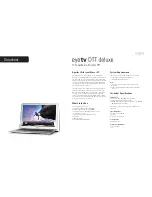
9
LC4.6U
8
LC4.6U
9
LC4.6U
8
LC4.6U
Índice deste capítulo:
1. Pontos de teste
2. Modos de Serviço
3. Problemas e Dicas de Solução (relacionado ao CSM)
4. ComPair
5. Códigos de Erro
6. O Procedimento do LED Piscando
7. Encontro de Falhas e Dicas de Solução
5.1 Pontos de Teste
Este chassis é equipado com vários pontos de teste.
Estes pontos de teste são identificados nos esquemas elétri-
cos com um retângulo em torno de Fxxx ou Ixxx. Nos paineis,
os pontos de teste são identificados com uma “meia lua” com
um ponto no centro.
Realize as medições sob as seguintes condições:
• Aparelho no Modo padrão de alinhamento.
• Entrada de Vídeo: sinal de barras coloridas.
• Entrada de Áudio: 3 KHz no canal esquerdo e 1 kHz no
direito.
5.2 Modos de Serviço
Modo de Serviço Padrão (SDM) e Modo de Serviço de Ajuste
(SAM) oferecem várias funções de serviço técnico, enquanto
o Modo Serviço de Cliente (CSM) é usado para comunicação
entre o centro de atendimento e o cliente.
Este chassis também oferece a opção de usar o ComPair, um
interface de hardware entre um computador e o chassis do TV.
Oferece estrutura de pesquisa de defeitos, leitura de código de
erros, e versão do software para todo o chassis.
Requisitos mínimos para o ComPair: um processador Pentium,
OS Windows e um drive de CD-ROM (veja ComPair).
5.2.1 Modo de Serviço Padrão (SDM)
Propósito
• Criar um ajuster pré-definido para obter os mesmos resul-
tados de medição como neste manual.
• A possibilidade de sobrepor proteções de SW.
• Para iniciar o procedimento de LED piscando.
• Para inspecionar o buffer de erro.
• Para verificar o tempo de vida.
Especificações
• Frequência de sintonia: 61.25 MHz (canal 3).
• Sistema de cores: NTSC M/N.
• Todas as funções da imagem em 50% (brilho, cor, con-
traste e matiz).
• Graves, agudos e balanço em 50%, volume em 25%.
• Todos os modos de serviço (se presentes) estão desativa-
dos. Os modos de serviço:
- Tempo/ Temporizador de sleep.
- Controle de programação pelos pais.
- Blue mute (tela azul).
- Modo Hotel.
- Desligamento automático ( quando nenhum sinal de
vídeo é recebido em 15 minutos).
- Salto de canais não pré-ajustado / não favorito.
- Auto-armazenamento do pré-ajuste pessoal.
- Time-out do menu de usuário.
- Nível Automático de Volume.
Como entrar no SDM
Utilize um dos seguintes metódos:
• Use o controle remoto e entre com o código 062596 direta-
mente seguida pela tecla MENU (digite rapidamente a
sequência para não atingir o time out do menu OSD).
• Curto-circuito no jumper SDM (item 4022, veja figura “Ser-
vice jumpers”) no painel TV e aplique a alimentação.
Remova o curto após ligá-lo.
Cuidado:
Entrando no SMD via curto-circuito, a proteção
de 5V é desabilitada. A desabilitação da proteção só pode
ser feita por um curto período.
Este procedimento deve
ser feito por um técnico que saiba exatamente o que está
fazendo pois poderá danificar o aparelho.
Figura 5-1 Jumpers de serviço SDM
Depois de entrar neste modo, SDM aparece no lado direito
superior da tela.
Figura 5-2 Menu SDM (exemplo do LC4.2E)
Como navegar
Quando você pressionar a tecla MENU no controle remoto, o
aparelho ligará o menu normal do usuário no modo SDM.
Como sair
Mude para o modo STANDBY no controle remoto ou no aparelho.
Se você desligar o aparelho desligando a rede (isto é, desligando
pela tomada) sem usar a tecla liga/desliga, o aparelho volta ao
SDM. Quando a tecla liga/desliga for usada novamente, o buffer
de erro não será apagado.
5. Modos de serviço, códigos de erros e localização de falhas
Service Modes, Error Codes, and Fault Finding
EN 9
LC4.6U AA
5.
5.
Service Modes, Error Codes, and Fault Finding
Index of this chapter:
1.
Test Points
2.
Service Modes
3.
Problems and Solving Tips (related to CSM)
4.
ComPair
5.
Error Codes
6.
The Blinking LED Procedure
7.
Fault Finding and Repair Tips
5.1
Test Points
This chassis is equipped with test points in the service printing.
In the schematics test points are identified with a rectangle box
around Fxxx or Ixxx. These test points are specifically
mentioned in the service manual as “half moons” with a dot in
the centre.
Perform measurements under the following conditions:
•
Television set in Service Default Alignment Mode.
•
Video input: Color bar signal.
•
Audio input: 3 kHz left channel, 1 kHz right channel.
5.2
Service Modes
Service Default mode (SDM) and Service Alignment Mode
(SAM) offers several features for the service technician, while
the Customer Service Mode (CSM) is used for communication
between the call centre and the customer.
This chassis also offers the option of using ComPair, a
hardware interface between a computer and the TV chassis. It
offers the abilities of structured troubleshooting, error code
reading, and software version read-out for all chassis.
Minimum requirements for ComPair:
a Pentium processor, a
Windows OS, and a CD-ROM drive (see also paragraph
"ComPair").
5.2.1
Service Default Mode (SDM)
Purpose
•
To create a predefined setting for measurements to be
made.
•
To override software protections.
•
To start the blinking LED procedure.
•
To inspect the error buffer.
•
To check the life timer.
Specifications
•
Tuning frequency: 61.25 MHz (channel 3) for NTSC.
•
Color system: NTSC M/N.
•
All picture settings at 50% (brightness, color contrast, hue).
•
Bass, treble and balance at 50%; volume at 25%.
•
All service-unfriendly modes (if present) are disabled. The
service unfriendly modes are:
–
Timer / Sleep timer.
–
Child / parental lock.
–
Blue mute.
–
Hotel / hospital mode.
–
Auto shut off (when no “IDENT” video signal is
received for 15 minutes).
–
Skipping of non-favourite presets / channels.
–
Auto-storage of personal presets.
–
Auto user menu time-out.
–
Auto Volume Levelling (AVL).
How to enter
To enter SDM, use one of the following methods:
•
Press the following key sequence on the remote control
transmitter: “062596” directly followed by the MENU button
(do not allow the OSD display to time out between entries
while keying the sequence).
•
Short SDM jumper (item 4022, see Figure "Service
jumper") on the TV board and apply AC Power. Remove
the short after start-up.
Caution
: Entering SDM by shorting "Service" jumpers will
override the software protections. Do this only for a short
period.
When doing this, the service-technician must
know exactly what he is doing, as it could damage the
television set
.
Figure 5-1 SDM Service jumper
After entering SDM, the following screen is visible, with SDM in
the upper right corner of the screen to indicate that the
television is in Service Default Alignment Mode.
Figure 5-2 SDM menu (example from LC4.2E)
How to navigate
When you press the MENU button on the remote control, the
set will switch on the normal user menu in the SDM mode.
How to exit
Switch the set to STANDBY by pressing the POWER button on
the remote control transmitter.
If you turn the television set off by removing the mains (i.e.,
unplugging the television) or by using the POWER button on
the TV set, the television set will remain in SDM when mains is
re-applied, and the error buffer is not cleared.
I2C
UART
E_14710_062.eps
260804
SDM
00022 LC42EP1 2.03/S42GV1 2.02 SDM
ERR 0 0 0 0 0
OP 000 057 140 032 120 128 000
E_14710_006.eps
240604
Service Modes, Error Codes, and Fault Finding
EN 9
LC4.6U AA
5.
5.
Service Modes, Error Codes, and Fault Finding
Index of this chapter:
1.
Test Points
2.
Service Modes
3.
Problems and Solving Tips (related to CSM)
4.
ComPair
5.
Error Codes
6.
The Blinking LED Procedure
7.
Fault Finding and Repair Tips
5.1
Test Points
This chassis is equipped with test points in the service printing.
In the schematics test points are identified with a rectangle box
around Fxxx or Ixxx. These test points are specifically
mentioned in the service manual as “half moons” with a dot in
the centre.
Perform measurements under the following conditions:
•
Television set in Service Default Alignment Mode.
•
Video input: Color bar signal.
•
Audio input: 3 kHz left channel, 1 kHz right channel.
5.2
Service Modes
Service Default mode (SDM) and Service Alignment Mode
(SAM) offers several features for the service technician, while
the Customer Service Mode (CSM) is used for communication
between the call centre and the customer.
This chassis also offers the option of using ComPair, a
hardware interface between a computer and the TV chassis. It
offers the abilities of structured troubleshooting, error code
reading, and software version read-out for all chassis.
Minimum requirements for ComPair:
a Pentium processor, a
Windows OS, and a CD-ROM drive (see also paragraph
"ComPair").
5.2.1
Service Default Mode (SDM)
Purpose
•
To create a predefined setting for measurements to be
made.
•
To override software protections.
•
To start the blinking LED procedure.
•
To inspect the error buffer.
•
To check the life timer.
Specifications
•
Tuning frequency: 61.25 MHz (channel 3) for NTSC.
•
Color system: NTSC M/N.
•
All picture settings at 50% (brightness, color contrast, hue).
•
Bass, treble and balance at 50%; volume at 25%.
•
All service-unfriendly modes (if present) are disabled. The
service unfriendly modes are:
–
Timer / Sleep timer.
–
Child / parental lock.
–
Blue mute.
–
Hotel / hospital mode.
–
Auto shut off (when no “IDENT” video signal is
received for 15 minutes).
–
Skipping of non-favourite presets / channels.
–
Auto-storage of personal presets.
–
Auto user menu time-out.
–
Auto Volume Levelling (AVL).
How to enter
To enter SDM, use one of the following methods:
•
Press the following key sequence on the remote control
transmitter: “062596” directly followed by the MENU button
(do not allow the OSD display to time out between entries
while keying the sequence).
•
Short SDM jumper (item 4022, see Figure "Service
jumper") on the TV board and apply AC Power. Remove
the short after start-up.
Caution
: Entering SDM by shorting "Service" jumpers will
override the software protections. Do this only for a short
period.
When doing this, the service-technician must
know exactly what he is doing, as it could damage the
television set
.
Figure 5-1 SDM Service jumper
After entering SDM, the following screen is visible, with SDM in
the upper right corner of the screen to indicate that the
television is in Service Default Alignment Mode.
Figure 5-2 SDM menu (example from LC4.2E)
How to navigate
When you press the MENU button on the remote control, the
set will switch on the normal user menu in the SDM mode.
How to exit
Switch the set to STANDBY by pressing the POWER button on
the remote control transmitter.
If you turn the television set off by removing the mains (i.e.,
unplugging the television) or by using the POWER button on
the TV set, the television set will remain in SDM when mains is
re-applied, and the error buffer is not cleared.
I2C
UART
E_14710_062.eps
260804
SDM
00022 LC42EP1 2.03/S42GV1 2.02 SDM
ERR 0 0 0 0 0
OP 000 057 140 032 120 128 000
E_14710_006.eps
240604
Содержание LC4.6U
Страница 3: ...3 LC4 6U 3 LC4 6U 1 3 ...
Страница 6: ...6 LC4 6U 6 LC4 6U 3 INSTRUÇÕES DE USO Veja o manual de usuário no GIP ...
Страница 68: ...68 LC4 6U 68 LC4 6U 7 Circuit Diagrams and PWB Layouts Personal Notes E_06532_013 eps 060804 ...
Страница 72: ...72 LC4 6U 72 LC4 6U Tabela 8 2 Códigos de Options para todas as telas ...
Страница 84: ...www s manuals com ...










































